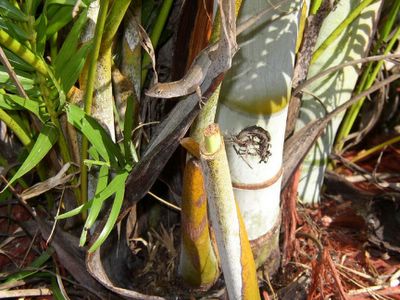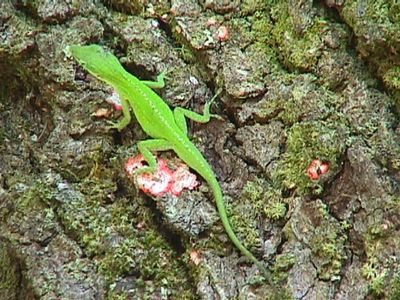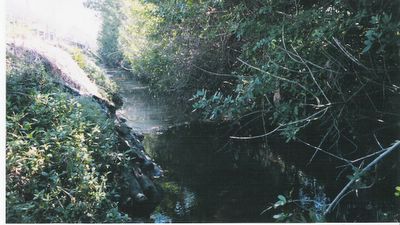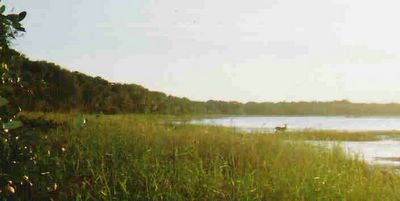
This picture from Fotosearch sums up a fraction of frustration in finding smaller Animalia in Florida. But it isn't the feral cat's fault. It's ours.

A fledgling Florida native paints questionable pictures of the world through rational perspective, empirical observations, and enlightenment of the fourth kind.



The Environmental Protection Agency (EPA) allows atrazine levels of 3 parts per billion (ppb) in potable water. Tyrone Hayes of the University of California, Berkeley found that when tadpoles were exposed to atrazine levels of only 0.1 ppb they developed extra testes, or even ovaries. Atrazine promotes the conversion of testosterone to estrogen, which explains why male frogs often developed both male and female sexual organs. Also, when adult frogs were exposed to these low levels they developed smaller larynxes and had only one-tenth the testosterone level of unexposed frogs. [Proc Natl Acad Sci USA 02;99(8):5476-80]
In another study on the effects of bioaccumulation, researchers found that reproduction was disrupted in female orniths that were exposed to estrogen at levels now commonly found in the wild. Finches exposed to estrogen produced fewer eggs and had more fragile shells. Numbers of hatchlings fell dramatically and the newborns had malformed oviducts. [Horm Behav 02;41(2):236-41]


The Coming of the Change
Thought I'd do something a little different and post my panel group presentation research paper from Spring Semester. This was for an Honors Interdisciplinary: Renaissance class. Warning: the following material is posted on Turn It In , an anti-plagiarism site for undergraduates. If you erase the author's name and put your own in its place, your teacher may know, and you could be penalized for it, including disciplinary interventions. And yet, cite it properly all you like. Sorry, all three professors for this class required submitting papers to this site.
As natural science develops and spreads to different parts of the globe, Arabians, Europeans, and Chinese form separate yet similar conclusions on its worth, application and meaning through interpretation according to authoritative belief systems and ancient thought between 1400 and 1700 AD.
The established order and understanding brought by authoritative indoctrination was coming under question for Arabian culture through introduction and digestion of works by Aristotle. "[Aristotelianism in] … Greek and Islamic science had become magic terms … depending on how one felt toward modern ideas and their unsettling impact on fixed intellectual ways.” (Dr Goldstein 245)
The influence of Aristotelianism is the work of one classical thinker, an Athenian man named "Aristotle … [who] spent several years in travel and study, crossing the Aegean Sea to Asia Minor [and its coastal islands]. During this period he undertook biological studies … For Aristotle … a brilliant zoologist, the growth and development of biological organisms [was] easily explained [using his own philosophical views] … the product of this research effort was a series of large zoological treatises … [Aristotle] admitted that animals are ignoble by comparison with the heavens and acknowledged that zoological studies are distasteful to many. However, he considered this distaste childish … he argued that in zoological studies the quantity and richness of the available data compensate for the ignobility … He argued, moreover, that zoological studies contribute to knowledge of the human frame owing to the close resemblance between animal and human nature … [he] acknowledged the gathering of biological data as the first order of business. His History of Animals, which was intended to meet this first need, is a vast storehouse of biological information … Aristotle made [one of] his greatest contributions … in descriptive zoology … in his History of Animals … structure and behavior of many [Animalia is] described in considerable detail, often [through] skillful dissection … [Aristotle devotes] … attention to … theoretical problems [in nomenclature] , [and] in practice Aristotle adopted "natural" or popular groupings based on multiple attributes … his works [are] plentiful evidence of empirical method, including dissection." (Lindberg 47-67)
Information of such depth and magnitude has far-reaching impact upon outstanding traditions and practices, and how one views placement in nature and the universe, namely in the idea of man related to animal, an idea contrary to popular belief during the Renaissance period in Arabia. Aristotle’s influence, through absorption and acceptance of Aristotelianism, is infamous in the Middle East, however, let us not forget: "There are two aspects of Islamic science, on the one hand the scientific ideas which were imported from outside and, on the other, the contribution of the Arabs themselves to the sum of scientific knowledge." (Ronan 202) Often an emphasis is made on retention of ancient thought by Arabs, "in favor of the more exciting advances which were to come in Western Europe from the sixteenth century onwards. Too often science in Arabia has been seen as nothing more than a holding operation." (Ronin 203) Arabia's contribution to natural science is not only through retention of ancient thought, but by experimentation, classification, and observation. "In biology … the Arabians inherited a vast amount of material from the Greeks … To Arabian philosophers, plants were primarily studied for their use either in agriculture or in medicine, an attitude taken at the beginning by Jabir ibn Hayyan … which set the seal on much that followed … [in] zoology the Arabian peoples were familiar with the life and habits of all the domesticated animals which … provide the basis of living for nomadic tribes." (Ronan 233-234) This means that cultures in the Middle East are more interested in practical, everyday applications of advancing natural sciences in the Renaissance rather than understanding the world around them and their place in it, although Arabs were no exception. In the fourteenth century "Kamal al-Din al-Farisi wrote The Great Book on the Life of Animals. This proved to be the foremost late Muslim work on zoology; in it al-Farisi systematized all previous studies and so produced a large compendium of zoological knowledge … [which then spread to other regions]." (Ronan 234) This interest in zoology and botany carried into the Mughal era of India after the translations made of al-Farisi’s book into Turkish and Persian, due to its religious as well as factual material. The Mughal emperor of India, Jahangir, devoted entire sections of his work Book of Jahangir to careful descriptions of plants and animals. (Ronan 235) Such empirical observations of nature and of living things gave Arabian culture a better understanding of their place in the world and brought order to imbalance established through the introduction of ancient thought.
For Europeans as with Arabs, though far more traumatic, the imbalance and instability caused by the introduction of Greek thought began to see a tilt of normalcy through "… Bacon's development of the principle of experimental science … For thousands of years before Bacon … it was normal practice to accept the word of authorities rather than to observe anew, frame hypotheses, and test them using scientific principles. But Bacon, like the modern scientists who followed him, rejected this "natural philosophy". He would not accept pure argument; everything should be subjected to experiment." (Clegg 3) As in some Arabian circles, though in far greater terms for Europeans, authority did not appeal to any form of science and in fact often publicly denounced any dalliance in natural sciences. The attitude accredited to Galileo was essential in breaking away from established classifications, though others, such as Dewey, would appeal to a different approach: "It is not easy to break away from current and established classifications of the world. The difficulty in this respect, however, is eased by the notion that after all it is only error that the mind needs to cut loose from, and that it can only do this by direct appeal to nature, by applying pure observation and reflection to pure objects." (Dewey 219) Like a very familiar Grecian philosopher, Bacon suggests an establishment of collaborative thinkers, "[One] … of Bacon's many fertile suggestions for the improvements of science, probably the most fruitful one was his proposal … [in] The New Atlantis, [Bacon] includes an academy of scientists, liberally provided with brains and funds. A few such academies already existed when Bacon wrote, but after Atlantis they sprang up everywhere … but not all … were adequately financed. The most important of them was the English society which … was finally chartered in 1662 as the Royal Society of London for the Improvement of Natural Knowledge." (Gay 17) Consideration of providing an organization of scientists is a great example of the import of science on the changing worldview in the natural sciences for Europeans. It was worth sharing and managing, thanks due in part to duress caused by authoritative indoctrination. It was Bacon who also said: "I cannot but be raised to this persuasion, that this third period of time will far surpass that of the Grecian ... learning, only if men will know their own strength and weakness both, and take one from the other light of invention, and not fire of contradiction."(Sutton 12) Yet even with all their similarities in empirical methodologies, Bacon yet holds hostility to Aristotle, and "says empiricists were mindless ants that gathered bits of information but didn't use it or know how to apply the data to practical purposes."(Magee 74-75). Indeed, in Europeans, a lack of control in nature and a feeling of helplessness led to an exploration in ways in which to understand and explain, and thus bring under control again, the events, creatures and environments that surround and inhabit the biosphere. But Europeans also made unique discovery for the sake of discovery alone, rather than finding a practical purpose for advancements in natural science. A traveling naturalist which frequented the Middle East, “Pierre Belon … published several zoological works, discovering that cetaceans were mammalian and not fish through empirical dissection, and published his findings for critical analysis by peers. He also compared the anatomy of birds to human structure, a pioneering study that earns him the title “Father of Comparative Anatomy”. (Ronan 283-284) Although dissection held negative implications in its practice, authoritative doctrine on such policies slowly began to give way, allowing more discoveries to come forth.
A rise in the scientific worldview of nature could be seen in China during a period when interest had grown "in a "purer" age, when things were better – the age-old belief in a "golden age" back in the distant past."(Ronan 135). Confucianism and Taoism developed for a period of time and had become the leading intellectual philosophies, though there were other small groups. Aristotelianism and empirical methods show some similarities in Confucianism, in Taoism, and other Chinese philosophical branches. In Taoism, for example, "it was a mixture of religion and philosophy, magic and primitive science, and its name was derived from the aim of its followers to seek the Tao ... a philosophical and spiritual term for ... "The Order of Nature" in the sense of the essential power of the universe; not, it must be emphasized, power of a divine all-powerful personal ruler, but the immanent power of that vast organism which is at once man and the universe ... these beliefs stimulated a desire to ascertain the causes of things, to observe the natural world, and even to conduct experiments. The Taoist would contemplate Nature not out of idle curiosity but in the belief that the knowledge gained would bring inner peace. Instead of using this knowledge to gain mastery over nature (as was the inspiration of so much Western scientific inquiry), the Taoist would never undertake what would be considered "contrary" action to use force against Nature." (Ronan 135) After bitter battles between Confucians, Buddhists and Taoists, and a dip in Taoism, the "... revival of Taoism left the Confucians feeling very acutely their lack of any ideas about the universe and the natural world, an intellectual lacuna emphasized by the Buddhists, who had their own views on matters of this kind." (Ronan 136) The Chinese were avid naturalists, writing innumerable volumes of encyclopedias describing plants and animal species, though far more more botanical references, as pharmacological experimentation was of utmost import to their culture. "In the Western world there was little development [in natural sciences] after the Greeks until Renaissance times, but in China there was no such hiatus." (182) Given a greater breadth and variety of microcosms and the specimens they in turn held due to the vastness of the region, Chinese scientists had much more at their disposal to analyze critically and experiment upon than Western scientists or Middle-eastern scientists, and had more free reign in such dalliances due to their own intellectual perspectives.
Works of Aristotle flow into western culture during the Middle Ages from the Middle East. Through them, Europeans rediscover the ideal system of ecumenical laws. Philosophical, ethical, and religious views shift throughout the world as humanity digests this new intellectual influence. Through a vast series of empirical observations, man is found not central in the universe, nor is he central of it, but is an integral part of something much more substantial, interwoven. The introspection and retrospection brought on by this new perspective, being a part of a vast, relatively unknown whole, techniques like vivisection and dissection, and other forms of empirical methodology, all lead to greater awareness of interrelated microcosms and humanity's place in such things. This humanistic questioning leads to a collapse in certain truths the establishments of authoritative and religious traditions, values, and morals instilled in humanity. Balance is struck through a blending of traditions and science in many instances.
One of the most unsettling developments, when natural science was finally beginning to feel more acceptance in authoritative circles, was " … [an] inner ambivalence [of scientists and authority] that has always inspired a peculiar blend of awe, a mixture of apprehension and admiration, among those who witnessed science's dynamic rise ... [like] Medieval citizens terrified by the experiments of the alchemists ... Throughout its rise to power glaring ambiguities have made it difficult for the contemporaries to recognize that science, despite our tendency to see it in simple moral terms, is neither good nor bad but an impersonal force as morally neutral as a computer or a machine, whose ethical value depends in essence on our uses. Perhaps behind these age-old fears here always lurked some presentiment about science's future destructive potential ..." (Dr Goldstein X) Chinese natural scientists rarely felt this sentiment of ambiguity as most of their religious and philosophical establishments had incorporated ideas of the universe and nature that allowed for empirical observation, experimentation, and the questioning of their place in the universe, developing natural knowledge over a greater period of time, like the Arabs devoting the study of botany to medical and agricultural practical matters, yet still maintain an aloofness toward the notion of "conquering" what westerners would consider the "barriers" of the natural world.
Cohen, Bernard I. Album of Science: From Leonardo to Lavoisier, 1450-1800. Charles Scribner's Sons. New York 1980
Clegg, Brian The First Scientist: A Life of Roger Bacon Carroll & Graf Publishers, New York 2003 pg 3
Dewey, John Experience and Nature Dover Publications, Inc, New York 1958 pg 219
Dr Goldstein, Thomas Dawn of Modern Science: From the Arabs to Leonardo Da Vinci. Houghton Mifflin Company. Boston 1980 pg x, 245
Gay, Peter Age of Enlightenment. Time Incorporated. New York 1966 pg 17
Hamer, et al. Exploring the Old World Follett Publishing Company, New York 1957 pg. 177-178
Lindberg, David C. The Beginnings of Western Science. University of Chicago Press. Chicago. 1992 pg 47-67
Magee, Bryan The Story of Philosophy. DK publishing. New York 2001 pg 63-71
Ronan, Colin A. Science: Its History and Development Among the World's Cultures. The Hamlyn Publishing Group Limited. New York 1982 pg 135, 136, 202, 203, 233-234
Rubenstein, Richard E. Aristotle's Children: How Christians, Muslims, and Jews Rediscovered Ancient Wisdom and Illuminated the Dark Ages Harcourt, Inc, Florida 2003
Sutton, Ian, ed. Age of Expansion: Europe and the World 1559-1660 Thames and Hudson London 1968 pg 12


When you utilize backhoes or other machines, like bobcats or sodcutters, and remove the top layer of sod containing all the native seeds from the earth that have survived your consistent mowing habits and non-native plant revegetation pleasures, will the native plants survive? And when you make laws requiring that a resident remove native plants through non-native species requirements, grass, shrub, and tree height requirements, or landscaping requirements, what are you doing to the food sources for native wild animals?


Every day, I try to absorb myself with the native biota of the unfortunately urban sprawl. Often it's getting harder and harder to find the native biota interspersed with the new non-natives (some being highly invasive and costing millions to monitor and remove, including the highly predatorial non-native felines and Varanis species). Memories of crawling through the mangrove swamps to get to the nice, natural sandbars, say, of Fort Desoto Park, before much of the surrounding development had risen nearby, brings tears to my eyes when I look at what is left of it and many barrier islands and coastal areas of Florida today. Growing up in late 1900 Florida lends poignant memories of vast coastal and inland wetlands, pristine, potable-from-source waters, clean, breathable air. It is what brought many of the early residents down to this area, and continues to bring innumerable tourists and new residents, now making Pinellas County one of the most densely populated counties in the country. If we can maintain Florida's pristine waters and undeveloped lands, we will maintain our image as a popular destination for exploration, retirement and enjoyment. But mitigating the loss of wetlands through the construction of faux wetlands in another area is not a viable alternative.




One of the key negative elements in wetlands is bioaccumulation through exposure to man's shallower side. Those wetlands unlucky enough to lie beside burgeoning development pay full price, namely near new roadways, highways, and especially in Florida, condominiums and "marts", another Floridian slang term that perhaps describes discounted indoor markets. And let us not forget the coastally blocking, mangove filtration removing malbenefits of the ever-increasing shallow enterprise of high-rise units unfit for tropical sunset views and clean waters.
So what does that mean, anyhow? To mitigate oneself, or their life, let alone while in college? How can anyone find Apollonian insight or ecumenical balance in today's hectic schedule of events? Well, that's not my goal. This blog is an attempt to question mitigation of another sort altogether, but will also include some of my other projects and thoughts as the year moves forward (sometimes leaving me lagging a little behind).

